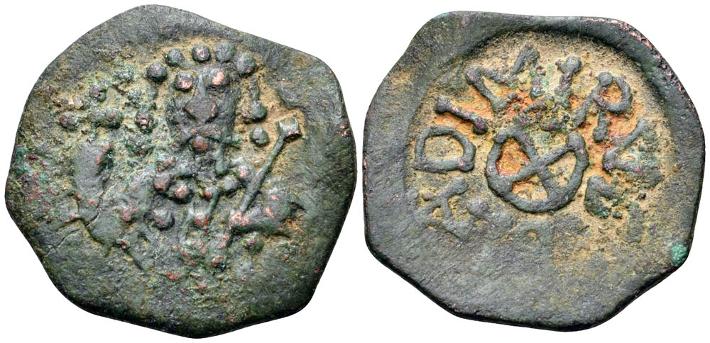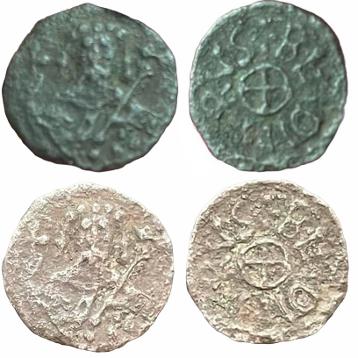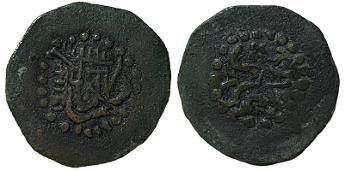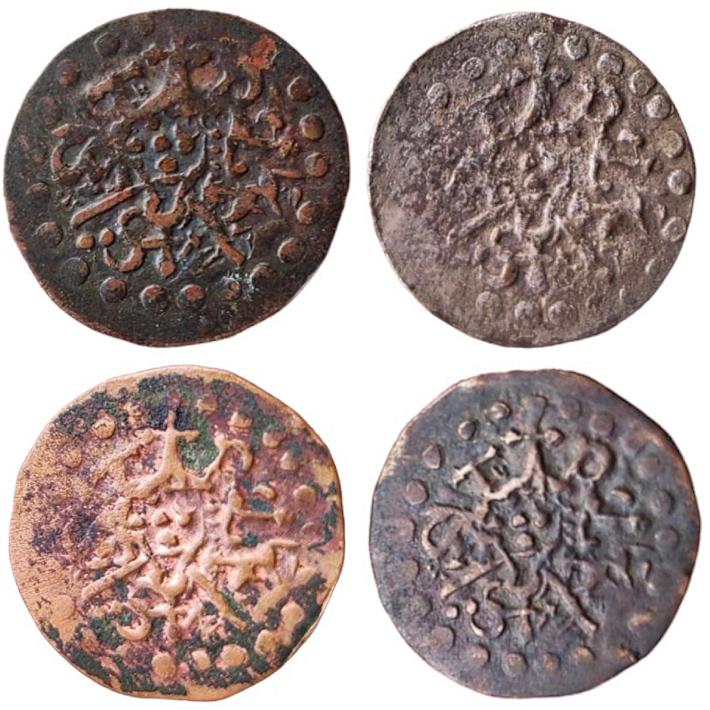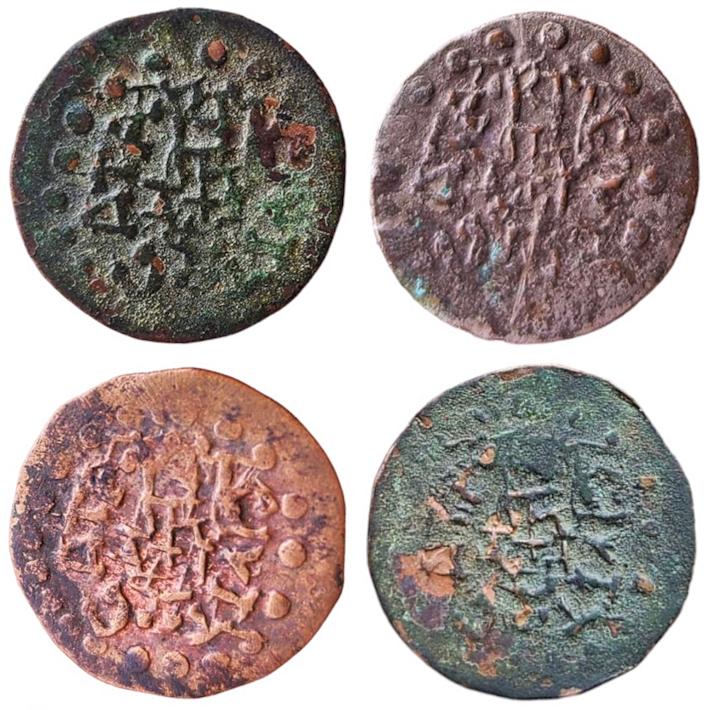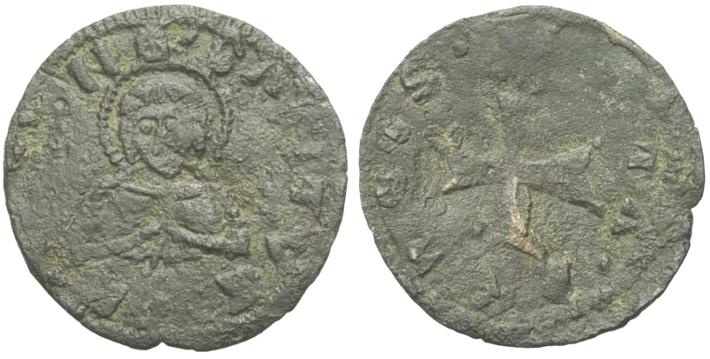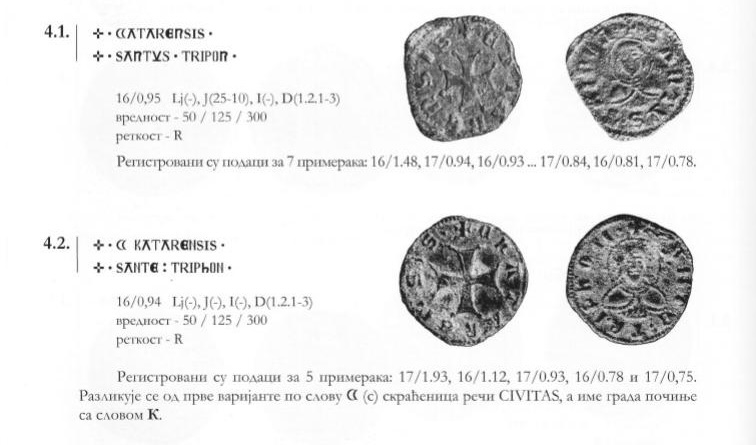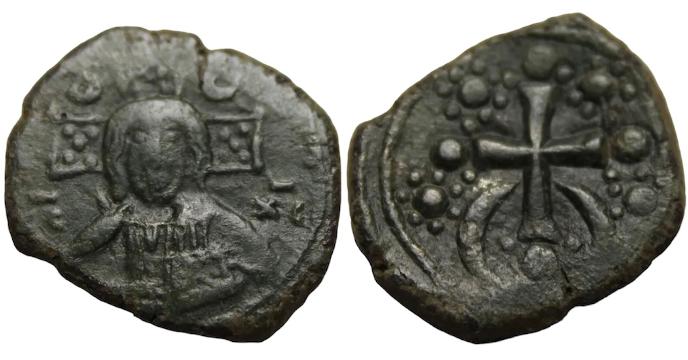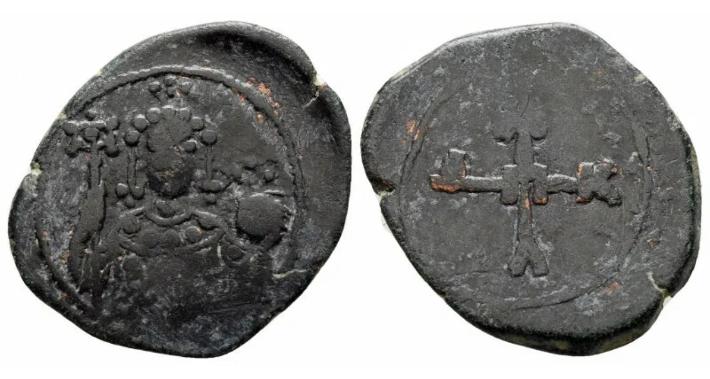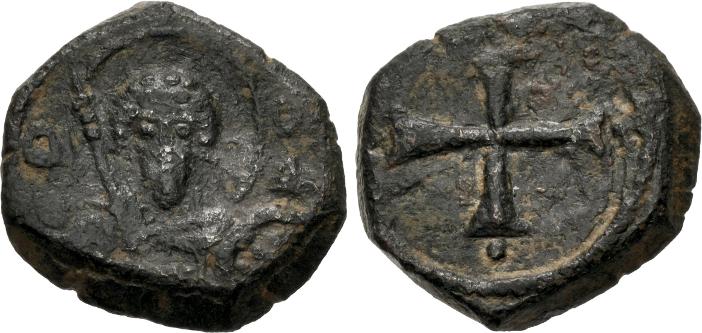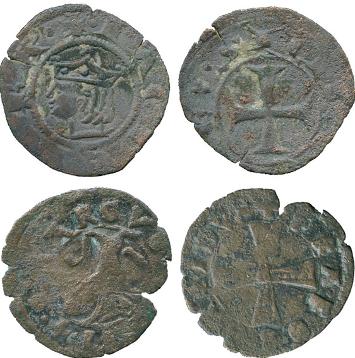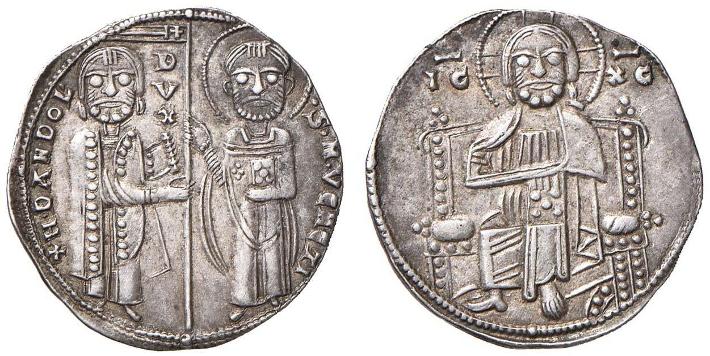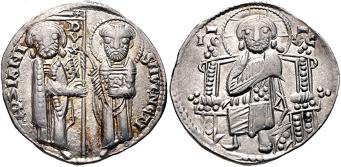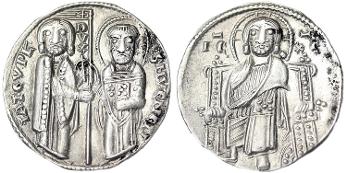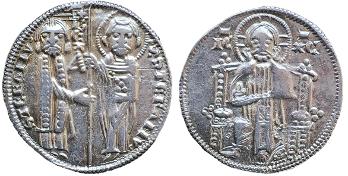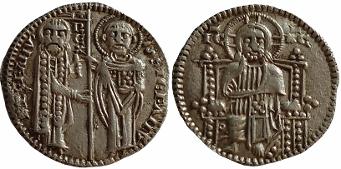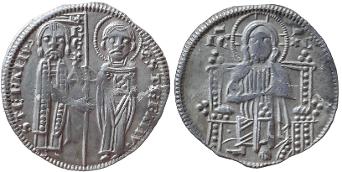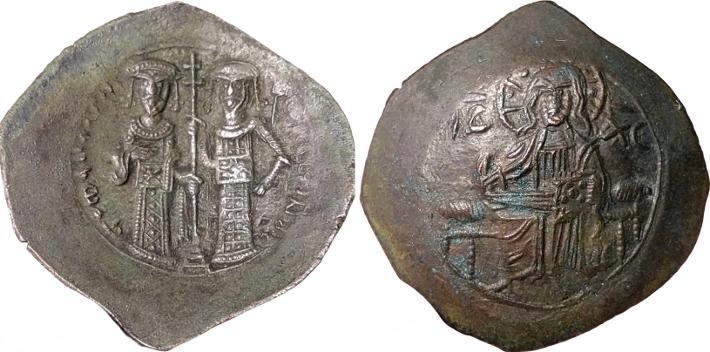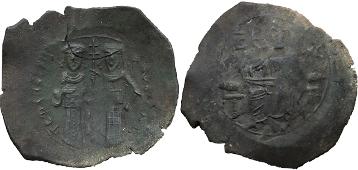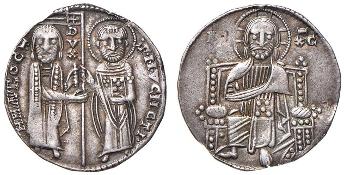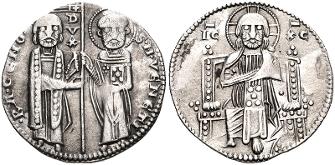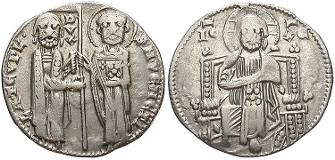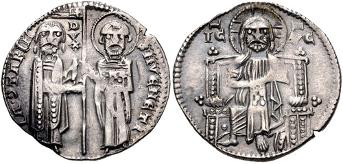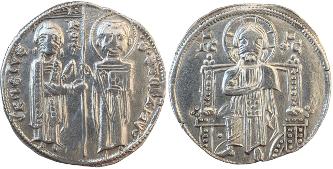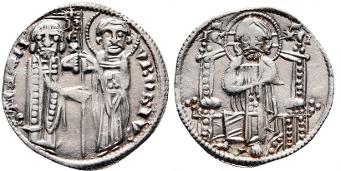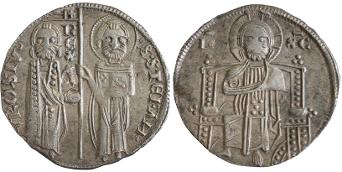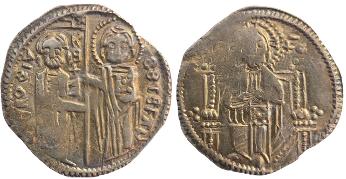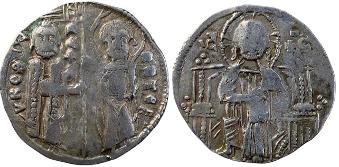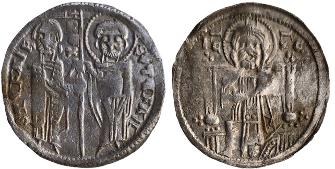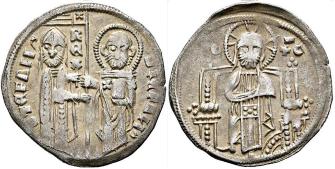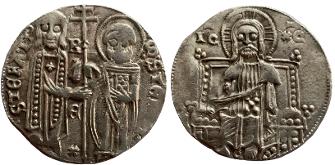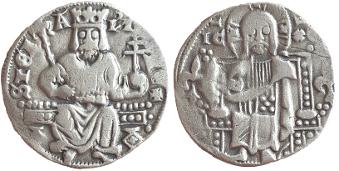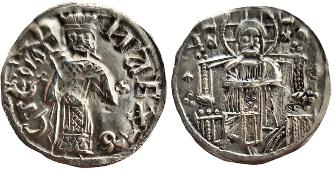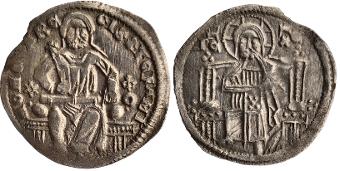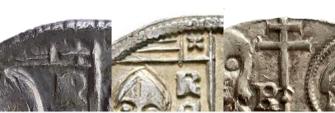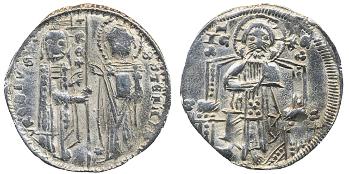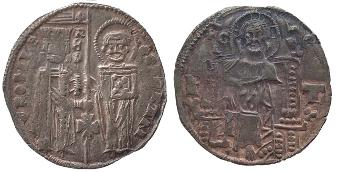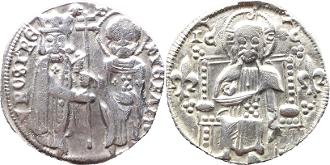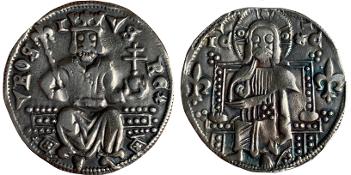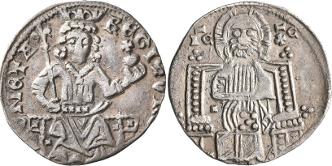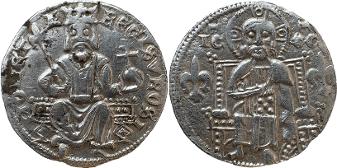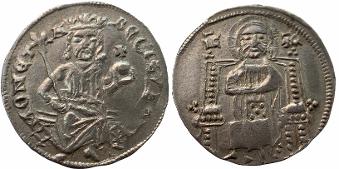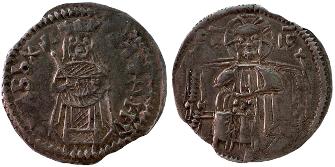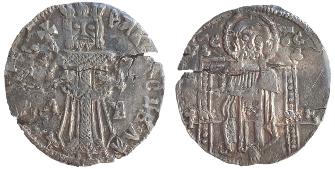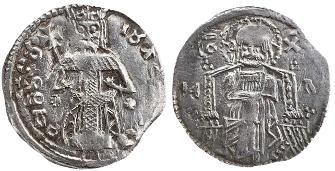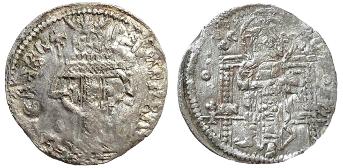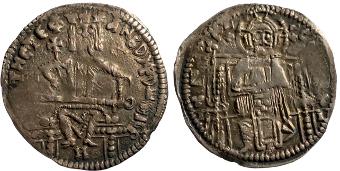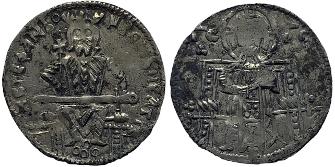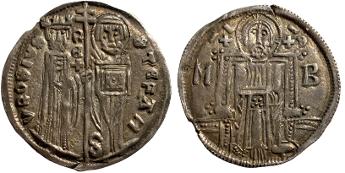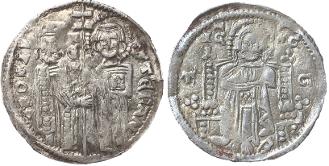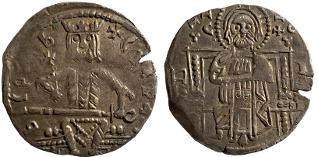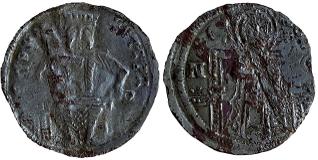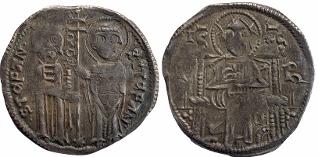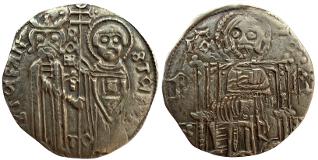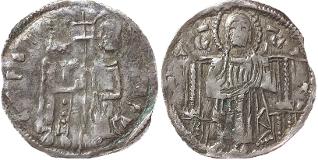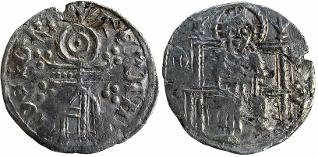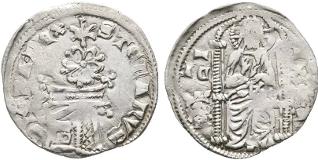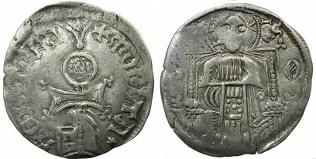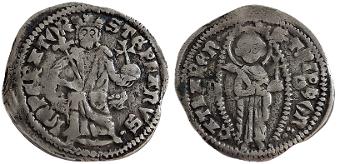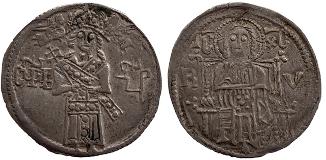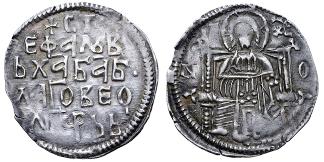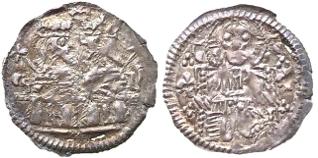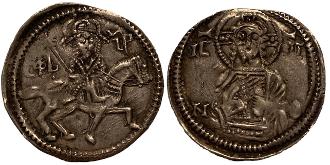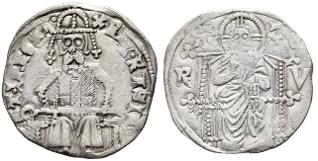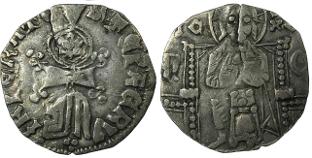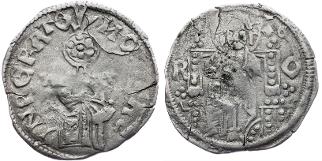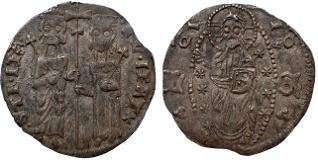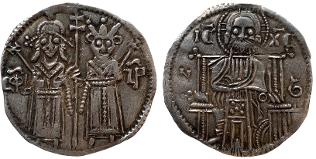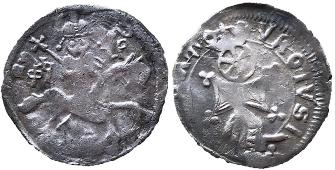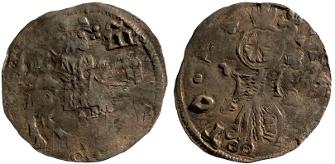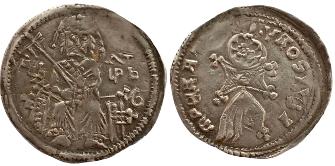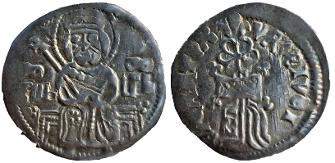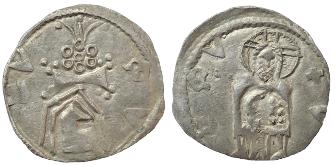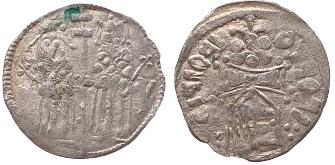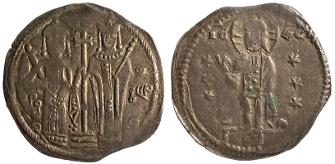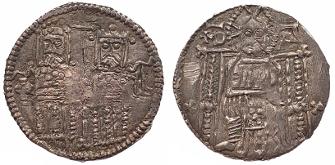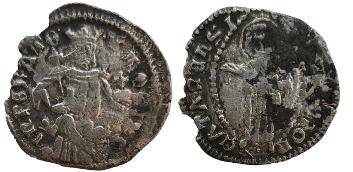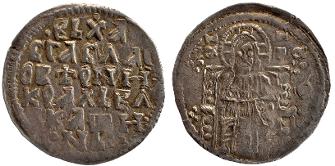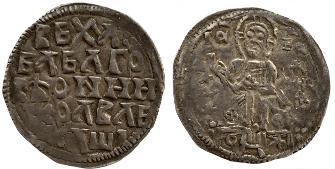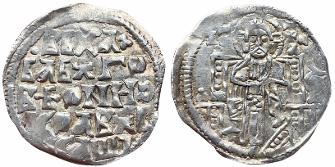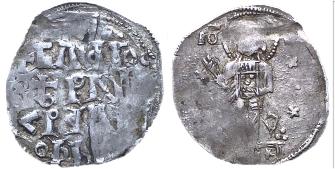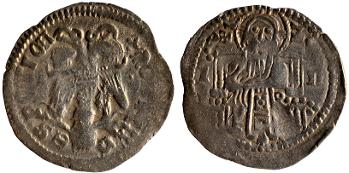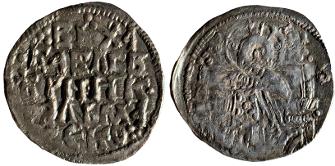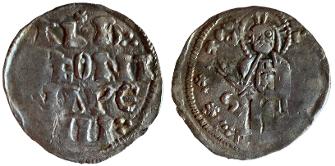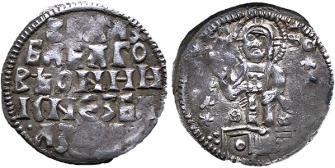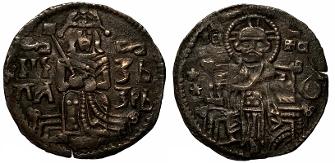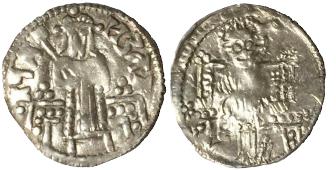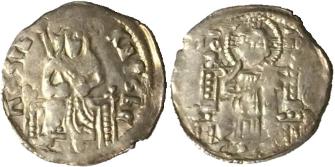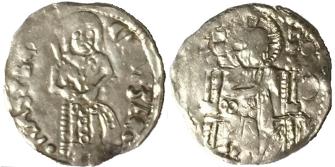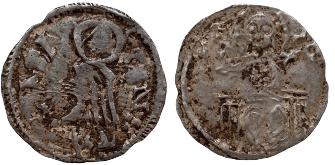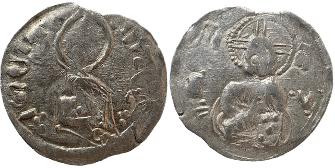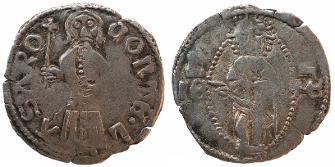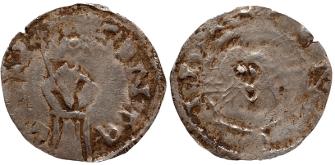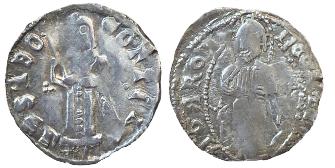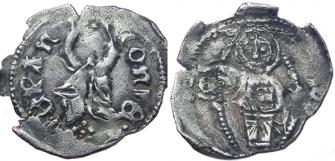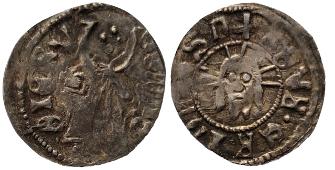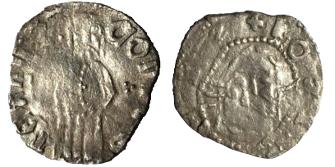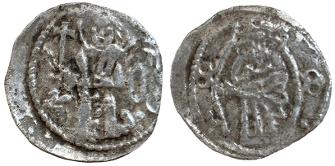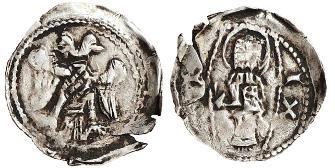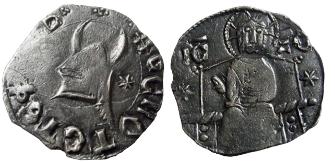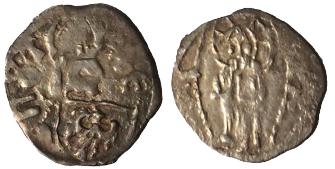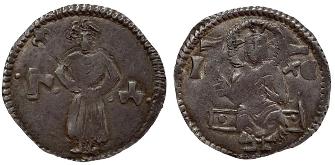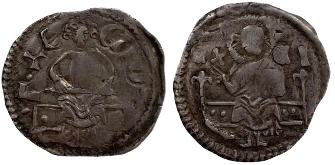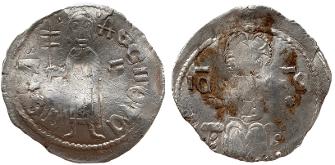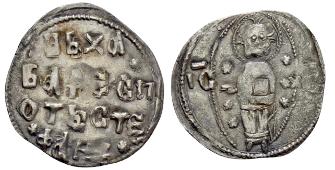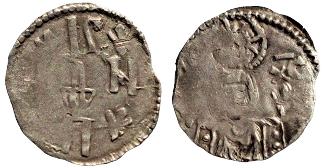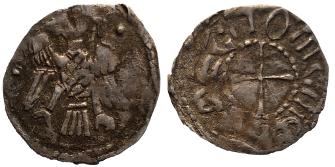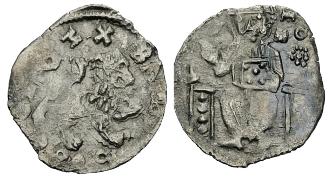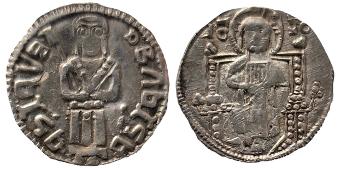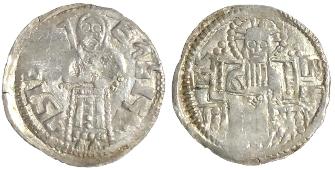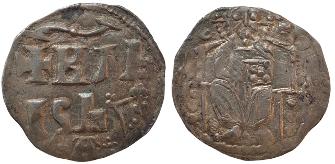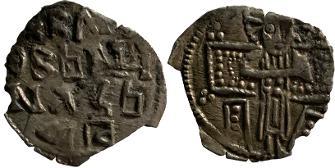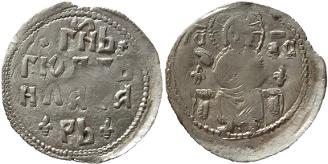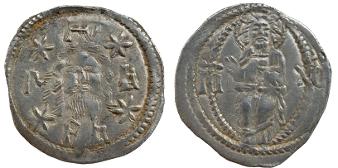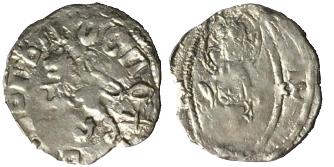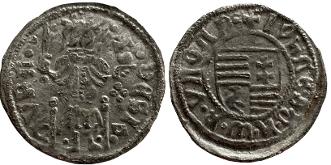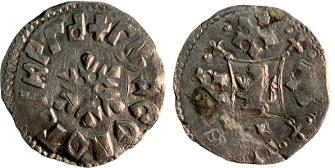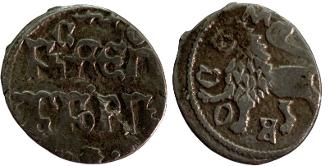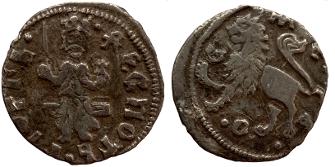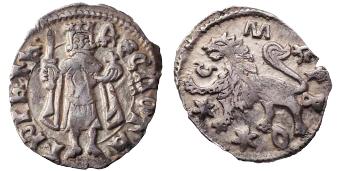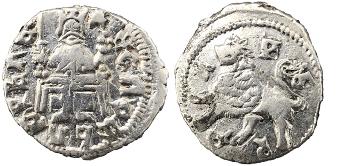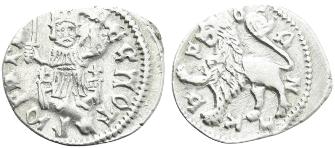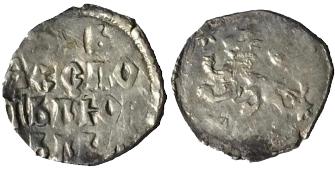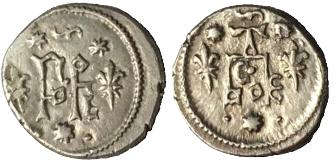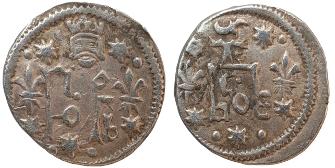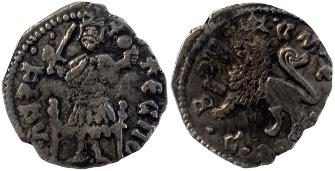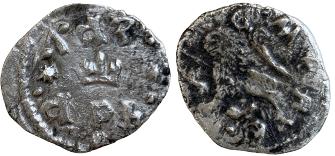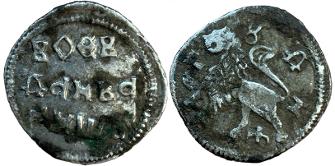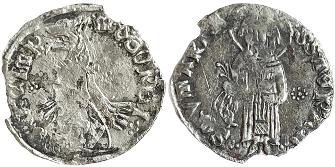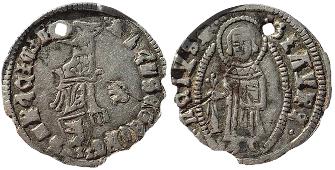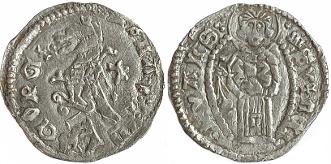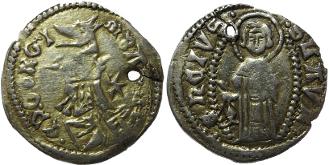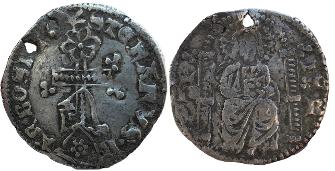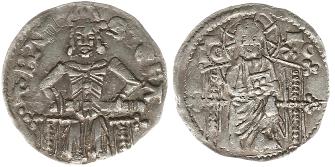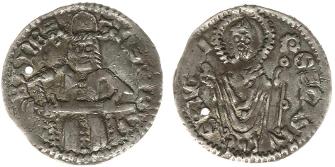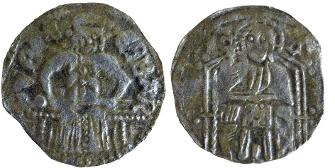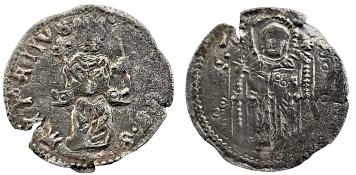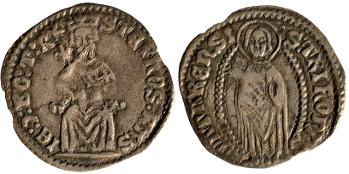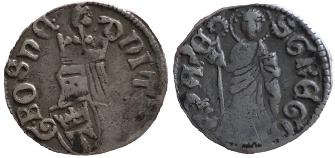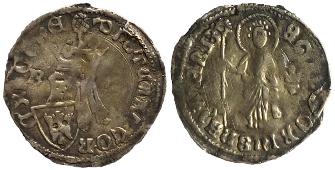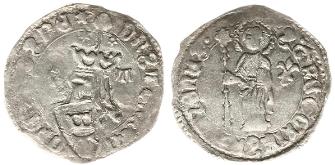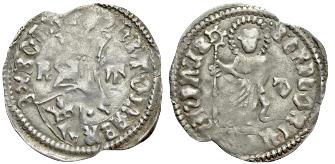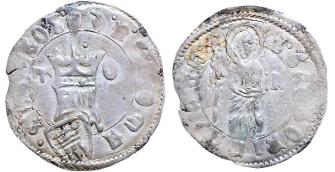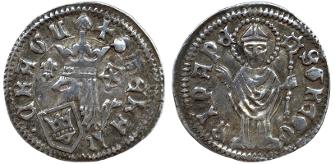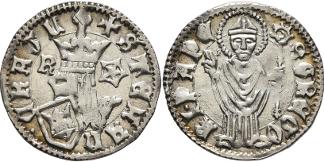350 YEARS OF MINTING HISTORY
KING VLADIMIR II VOJISLAVLJEVIC 1102-1114
It is generally believed that Serbian king Radoslav 1228-1234 first minted Serbian medieval coins.
However here is a very interesting hypothesis that actually minting started more then 100 years earlier!
Minting of Serbian medieval coins most likely began at the beginning of the 12th century during the rule of king Vladimir II Vojislavljevic 1102-1114.
Obverse: Ruler is featured with a curly hair, without crown and without REX royal title holding cross in his right hand and a scepter in his left hand which is symbol of kingly rule.
Reverse: Small cross in the middle within a circle and Latin description: BLADIMIRVS (VLADIMIR) around. Letter B in Latin languagephonetically reads VA so it can be read VALADIMIRUS.
20mm, 2.59g.
BYZANTINE RULE OVER THE STATE OF DUKLJA 1143-1166
Coins minted between the rule of king Vladimir II Vojislavljevic 1102-1114 and Grand Zupan Stefan Nemanja 1166-1196 are local city issues like these follaro type coins minted in the city of Kotor in the 12th century during the Byzantine rule.
Duklja including Kotor under Vojislavljević dynasty was independent from Byzantium from 1042 until Duklja was once again subdued by Byzantium in 1143, 100 years later. The city was conquered in 1185 by Stefan Nemanja, the ruler of the Grand Principality of Serbia and founder of the Nemanjić dynasty.
These primitive looking follaro types are most likely minted between 1143 and 1185.
First coin that's different from the other four and its probably older has visible Latin letters CATA for KOTOR.
These four on the obverse have a Byzantine ruler wearing a crown with a large cross in the middle and unclear name around. Visible letters are ST and R.
On the reverse possible city walls in the middle and Latin description around: CIVT CATA (THE CITIZENS OF KOTOR).
GRAND ZUPAN STEFAN NEMANJA 1166-1196
City of Kotor issue under Nemanjic rule (1186-1250)
Copper half follaro "cross" type. 16mm, 0.600g.
Obverse: Large cross in the middle. Latin description: + CATARENSIS • (KOTOR) around.
Reverse: Bust of Saint Trifon in the middle. Latin description: Θ • SANTVS TRIPhON (SAINT TRIFON) around.
Reference: Jov 25 4.2, Dobrinic 1.2.3.1-26
Due to strong Norman-Sicilian influence it could have been minted at any time between 1186 and 1250, from the rule of Serbian grand prince Stefan Nemanja (1166-1196) until the rule of king Uros The Great (1243-1276)!
Large cross in the middle on the obverse is also very similar to an Insignia of the Knights Hospitaller, the Maltese cross, and it’s very common on crusaders coins like Italian and German coins. it could have been minted during The Third Crusade 1189-1192 or The Fourth Crusade 1202-1204 what would bring it under grand zupan Stefan Nemanja rule 1166-1196 or his son grand zupan Stefan Nemanjic 1196-1217, later king Stefan The First Crowned 1217-1228.
If this coin has been minted during The Third Crusade, in that case it would be the only Serbian coin known to be minted during the life and rule of the founder of the medieval Serbian state of All Serbian Lands and Maritime, Grand Zupan Stefan Nemanja (1166-1196). It would make it the only known Nemanja coin and therefore of extreme historical importance!
Similar coins of other rulers in the area with a bust of the ruler on the obverse and a cross on the reverse indicating that such design was common from the end of the 11th century throughout the 12th century:
In 1193 a new type of coins began to be minted destined to become the most popular money in the world! The 41st doge of the Republic of Venice Enrico Dandolo 1192-1205 began minting silver matapan or gross type coins.
After 4th crusade, fall of Byzantine empire and sacking of Constantinople by Venetians and doge Enrico Dandolo 1202-1204, Latin empire is established and Venice controlled Adriatic sea, independent trade city of Dubrovnik and Byzantine lands all the way to the east and Black Sea. Trade routes made Venice and Dandolo family one of the richest in the world! Venetian money does became most popular currency in the world.
Obverse: Standing on the left doge Enrico Dandolo. Latin description: XN DANDOL, in the middle title DVX and on the right saint Mark the protector of Venice and Latin description: S M VENETI.
Reverse: Jesus seating on the throne, above IC XC (In Greek: Ιησούς Χριστός - Jesus Christ).
In 1206/1207 Serbian Grand Zupan Stefan Nemanjic 1196-1217 marries no other but the grand daughter of Enrico Dandolo, from one of the richest and most influential families in the world, Ana Dandolo. This relationship directly led to papa Honorius III granting him crown, king title and a kingdom. With the help of Venetian experienced moneyers and the silver provided by them, king Stefan The First Crowned 1217-1228 minted the first Serbian silver medieval coins.
Obverse: Standing on the left king Stefan The First Crowned. Latin description: STEFANV, in the middle title REX and on the right saint Stefan the protector of Serbia and Latin description: S STEFANV.
Reverse: Jesus seating on the throne, above IC XC (In Greek: Ιησούς Χριστός - Jesus Christ).
THE REPUBLIC OF VENICE 1192-1249
ENRICO DANDOLO 41ST DOGE OF VENICE 1192-1205
PIETRO ZIANI 42ND DOGE OF VENICE 1205-1229
JACOPO TIEPOLO 43RD DOGE OF VENICE 1229-1249
KING STEFAN RADOSLAV 1228-1234
As king Radoslav 1228-1234 was closely related to Byzantine royal family through his mother Eudokia Angelina, he started minting coins similar to Byzantine, larger, copper, cup types.
Copper cup "double cross" type coin. 29mm, 5.022g.
Obverse: King in imperial attire facing, standing with St Constantine holding double cross banner together. St Constantine is holding his own smaller banner or scepter. Greek Legend: CTEФANOC PIZ (STEFAN KING) on the left and on the right side Greek letter Theta Θ and KONCTANTH (SAINT CONSTANTINE) referring to Constantine the Great, also known as Constantine I who was a Roman Emperor who ruled between 306 and 337 AD and born on the territory of today's Niš Serbia.
Reverse: Jesus Christ sitting on the high throne holding book of gospels decorated with 5 gems in his left hand a blessing with his right hand. Greek letters: IC XC (In Greek: Ιησούς Χριστός - Jesus Christ) above. 4 dots inside halo, 2 on each side.
Reference: J ( 3 ), I ( 1.4 ), D (1).
It is very rare for 2 sons of a king to rule after their father but in medieval Serbia 3 sons of king Stefan The First Crowned ruled after each other. After the rule of king Radoslav 1228-1234 and king Vladislav 1234-1243, his 2 older brothers, king Uros The Great 1243-1276 ruled for 33 years. Only his son king Milutin will rule longer, 39 years from 1282 to 1321.
King Uros The Great 1243-1276, as his mother was venetian Ana Dandolo, retuned to venetian matapan Grosso type coins. After opening of first Serbian mine called Brskovo in 1250 Venetians started complaining and the quality of Serbian coins as well as their adherence to venetian standard began to decline.
Silver "banner" type coin. 20mm, 2.115g.
Obverse: Bare headed king receiving banner from saint Stefan , holding book of gospels decorated with 5 gems. Mixed Latin/Greek legend: VRωSIVS RςΨ • S • STEFANV, (UROS KING SAINT STEFAN). + on the flag of the banner. Flag is represented with 3 horizontal lines. Saint has 4 dotted pellet on his chest.
Reverse: Christ enthroned, holding book of gospels decorated with 5 gems. Greek letters: IC XC (In Greek: Ιησούς Χριστός - Jesus Christ) above. Single dot next to the right leg. 4 triple pellets around the throne.
Reference: Unpublished variant compare to Ljubic III, Maric 1956 T XIII 5/6, D 4 8.
THE REPUBLIC OF VENICE 1249-1280
MARINO MOROSINI 44TH DOGE OF VENICE 1249-1253
RENIERO ZENO 45TH DOGE OF VENICE 1253-1268
LORENZO TIEPOLO 46TH DOGE OF VENICE 1268-1275
JACOPO CONTARINI 47TH DOGE OF VENICE 1275-1280
KING STEFAN UROS THE GREAT 1243-1276
High quality mint, minted byeducated moneyer and matching venetian standard 2.178g +/- 1%, 20-21mm and 96-98% silver content.
Same quality with VROSIVS on the right side.
Later issue with S for saint not being upright like earlier issues but separated with two dots.
Obvious decline in quality minted after 1250.
Late issue in Uros The Great reign, low quality, minted by uneducated and inexperienced moneyer as some letters are missing in description like letters ANV on the right side.
With the rule of king Stefan Dragutin 1276-1282 Serbian medieval coins will develop into the most beautiful works or art! King Dragutin first changed standard cross to saint Andrews cross on the matapan type, first changedflag to double cross on the matapan type, first started minting other types and first issued coins with Cyrillic Serbian description.
During Nemanjic period Serbian kingdom will become empire under the rule of first Serbian emperor Stefan Dusan, king from 1331 to 1346 and emperor from 1346 to 1355. Nemanjic period will last until 1371 followed by Mrnjavcevic, Kotromanic, Lazarevic and Brankovic families.
KING STEFAN DRAGUTIN 1276-1282
Matapan type with a flag and standard cross in the middle.
Matapan type with a flag and saint Andrews cross in the middle.
Type with a double cross.
New type and first with king sitting on the throne holding scepter and globus.
First type with Serbian Cyrillic description.
Another new type, second with king sitting on the throne but first with sword over his lap with first use of Latin word MONETA.
Comparison of flag with standard cross in the middle, saint Andrews cross and a double cross.
KING STEFAN UROS THE SECOND MILUTIN 1282-1321
Matapan type with a flag and standard cross in the middle.
Matapan type with a flag and standard cross in the middle with extra cross on the handle.
Type with a double cross.
Second sitting type with king on the throne holding scepter and globus.
Third sitting type with king on the throne holding scepter and globus and use of Latin word MONETA.
Fourth sitting type with king on the throne holding scepter and globus and second use of Latin word MONETA.
Fifth sitting type with king on the throne holding scepter and globus and third use of Latin word MONETA.
KING STEFAN VLADISLAV THE SECOND 1321-1324
Standing type with king holding scepter and shorter description.
Standing type with king holding scepter, longer description and Λ -ᗺ moneyer marks.
Standing type with king holding scepter, longer description and M - Λ moneyer marks.
Standing type with king holding scepter, longer description beginning on the left side and o - o moneyer marks.
KING STEFAN UROS THE THIRD DECANSKI 1321-1331
Second sitting type with king on the throne holding sword and first appearance of royal title THE THIRD. Moneyer mark И.
Different position of letters, moneyer mark four circles.
Double cross type, first king that doesn't mint matapan flag type. Moneyer marks S and M - B.
Second double cross type with square crown. Moneyer marks T - C.
DUSAN AS KING STEFAN THE THIRD 1331-1346
Third sitting type with king on the throne holding sword and second type with Serbian Cyrillic description. Moneyer marks A - I.
Sitting type with king on the throne holding sword with Latin description. Moneyer marks N - δ (Greek delta)
Last type with king and saint holding double cross.
Another king and saint holding double cross type with very different kings face and crown.
King and saint holding double cross type with no REX title below double cross.
First helmet types. There is a possibility that his father first minted helmet type.
Helmet type with unusual arch above Jesus throne and first appearance of faces on reverse.
Helmet type with unusual opening in the shape of a bird on the helmet and fourth use of Latin word MONETA.
First type with ruler sitting on the throne with lion heads. Kotor mint 1346-1355.
DUSAN AS FIRST EMPEROR STEFAN 1346-1355
First imperial coronation type and only type that can be exactly dated to 16th April 1346. Emperor is holding double cross just as on his fresco in monastery Lesnovo. Moneyer marks R - V.
Second imperial type, first with in 5 lines description and third type with Serbian Cyrillic description. There is in 4 lines type as well.
First and only profile type.
First issue with emperor seating on the horse .
Fourth sitting type with king on the throne holding sword and first mention of the name of the state RASIE (RASKA).
Imperial helmet types with Latin description INPERATO.
Imperial helmet type with fifth use of Latin word MONETA.
First types with emperor and empress holding triple cross instead of saint. First triple cross appearance.
Another type with emperor and empress instead of saint but holding double cross.
SECOND EMPEROR UROS 1355-1371
Second imperial issue with emperor seating on the horse andfirst with horse on obverse and helmet with emperors name on the reverse combination. Obverse has fathers standard shorter description CФb ZP.
Third imperial issue with emperor seating on the horse and second with horse with emperors name on obverse and helmet with the titleon the reverse combination. Fathers CФb ZP is not present.
First imperial issue with emperor sitting on the throne and helmet on the reverse combination. Also first bilingual issue with Serbian Cyrillic description on obverse and Latin on reverse.
Second imperial issue with emperor sitting on the throne and helmet on the reverse combination. Second bilingual issue with Serbian Cyrillic description on obverse and Latin on reverse. Posthumous with oreol.
Third issue with helmet and Jesus standing on reverse similar to his fathers first issues as a king and as a emperor.
First combination of imperial couple Uros and Ana holding double cross and a helmet on the reverse.
Imperial couple standing together with another Serbian Cyrillic description
Imperial couple standing together with Jesus seating on the throne of reverse.
Second type with ruler sitting on the throne with lion heads. Kotor mint 1355-1371.
MRNJAVCEVIC FAMILY 1365-1395
KING VUKASIN MRNJAVCEVIC 1365-1371
Second description only issue with Serbian Cyrillic after emperor Dusan and first in 6 lines. Nikola Altomanovic has also issued in 6 and in 5 lines.
In 5 lines issue with Jesus standing on reverse.
In 5 lines issue with Jesus seating on the throne on reverse.
QUEEN JELENA MRNJAVCEVIC
Wife of king Vukasin and first female independent in 4 linesissue.
DESPOT UGLJESA MRNJAVCEVIC 1365-1371
Brother of Vukasin and ruler of Cer with interesting combination and a second issue with emperor Uros sitting on the throne on reverse and helmet with queens head on the top on obverse.
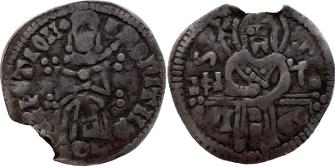
First use of double headed eagle still today a symbol of Serbian state.
KING MARKO MRNJAVCEVIC 1371-1395
Third with Serbian Cyrillic descriptionin 5 lines issue.
ANDREAS MRNJAVCEVIC
Fourth with Serbian Cyrillic description in 4 lines.
LAZAR FAMILY 1371-1427
KNEZ STEFAN LAZAR 1371-1389
Fifth with Serbian Cyrillic description in 5 lines issue and a title KNEZ.
Sitting type with Serbian Cyrillic description and a separated title KNEZ.
Standing type with Serbian Cyrillic description and a title KNEZ.
Sitting on the throne type with Serbian Cyrillic description and a title KNEZ
Another standing type with Serbian Cyrillic description and a title KNEZ but without crown.
LATIN ISSUES UNDER MILICA, LAZARS WIFE, AS A REGENT 1389-1393
First types with ox horn helmet and Latin title CONTE.
Ox horn helmet without clear description.
Standing type with Latin title CONTE and standing Jesus.
Standing type with Latin title CONTE and a face of Jesus on the reverse.
Standing type with Latin title CONTE with standing Jesus and additional description.
STEFAN LAZAREVIC AS KNEZ 1393-1402
Second types with ox horn helmet and Latin title CONTE.
Ox horn helmet type with Latin title CONTE and a face of Jesus on the reverse.
Standing type with Latin title CONTE and a face of Jesus on the reverse.
Issues without description are most likely later transitional issues from CONTE to DESPOT types.
Second double headed eagle issue after despot Ugljesa Mrnjavcevic.
STEFAN LAZAREVIC AS DESPOT 1402-1427
Third types with ox horn helmet with title DESPOT and Jesus seating on the throne on the reverse.
Ox horn helmet and a shield with Serbian Cyrillic title DESPOT and standing Jesus on the reverse.
Despot standing with Serbian Cyrillic initials for LORD DESPOT.
Since emperor Dusan this is fifth and final type with ruler sitting on the throne and holding a sword over his lap.
Standing type with double cross.
Sixth with Serbian Cyrillic description in 4 lines issue.
One of many monogram types.
Third double headed eagle type with Serbian Cyrillic title DESPOT.
BRANKOVIC FAMILY 1371-1458
VUK BRANKOVIC 1371-1397
First type with lion a symbol of Brankovic family.
Standing type with Serbian Cyrillic description.
Standing type with Serbian Cyrillic description and moneyer Jakov signature on the reverse.
In 2 lines type with Serbian Cyrillic description.
In 4 lines type with Serbian Cyrillic description and moneyer Jakov signature on the obverse.
DJURADJ AND LAZAR BRANKOVIC LORDS OF KOSOVO 1406-1410
Joint issue of middle and youngest son of Vuk Brankovic, Djuradj and Lazar.
DJURADJ BRANKOVIC LORD OF KOSOVO 1410-1412
After Lazars death, Djuradj rules on his own. Type with his faithful portrait.
Second type with lion a symbol of Brankovic family.
DJURADJ BRANKOVIC AS DESPOT 1427-1456
Joint Latin issue with Djuradj and John Hunyadi the regent of Hungary.
One of two snowflake Serbian Cyrillic types and small lion on the reverse.
Serbian Cyrillic type in 2 lines and with lion on the reverse. Smederevo mint.
Serbian Cyrillic type with despot sitting on the throne and with lion on the reverse. Smederevo mint.
Standing Serbian Cyrillic type with lion on the reverse. Smederevo mint.
Despot sitting on the throne with lion on the reverse. Novo Brdo mint.
Despot sitting on the throne with lion on the reverse. Rudnik mint.
Last type in 4 lines.
Serbian Cyrillic monogram type with despots name on the obverse and title on the reverse.
Serbian Cyrillic monogram type with despots name and face on the obverse and title on the reverse.
DESPOT LAZAR BRANKOVIC 1456-1458
Last Brankovic despot Serbian Cyrillic type with Lazar sitting on the throne and lion on the reverse. Smederevo mint.
Last Brankovic despot Serbian Cyrillic type with crown in the middle and lion on the reverse. Smederevo mint.
VOJVODA IVANIŠ KOVACEVIC 1450-1459
Vojvoda Ivaniš in 3 lines type with Brankovic lion on the reverse. Rudište mint.
BALSIC FAMILY 1385-1421
KOTROMANIC FAMILY 1322-1463
BAN STEFAN II KOTROMANIC 1322-1353
Helmet Latin type just like type of emperor Stefan Dusan.
Ban sitting on the throne and holding a sword over his lap type just like types of king Dragutin, king Stefan Uros III Decanski, king and emperor Dusan and despot Stefan Lazarevic.
Ban sitting on the throne and holding a sword over his lap type but with saint standing on the reverse.
TVRTKO AS BAN 1353-1377
Another ban sitting on the throne and holding a sword over his lap type with Jesus seating on the throne.
TVRTKO AS KING STEFAN TVRTKO I 1377-1391
Third sitting type with ruler sitting on the throne with lion heads and first type with the names of both Serbian states, RASKA and BOSNIA. Crown that king is wearing is Nemanjic royal crown. Bosnia mint 1377-1385.
Fourth sitting type similar to the one with ruler sitting on the throne with lion heads but lions heads were replaced and second type with the names of both Serbian states, RASKA and BOSNIA. Crown that king is wearing is Nemanjic royal crown. Kotor mint 1385-1391.
KING STEFAN TVRTKO II 1404-1409 AND 1421-1443
Small 17mm helmet type with Serbian Nemanjic crown and Latin description.
Large 25mm helmet type with Serbian Nemanjic crown and Latin description.
Smaller 23mm helmet type with Serbian Nemanjic crown and Latin description.
KING STEFAN TOMAS 1443-1461
Helmet type with Serbian Nemanjic crown and Latin description with R-T moneyer marks.
Helmet type with Serbian Nemanjic crown and Latin description with T-O moneyer marks.
KING STEFAN TOMASEVIC 1461-1463
Helmet type with Serbian Nemanjic crown and Latin description with a lily and a doublestar moneyer marks.
Helmet type with Serbian Nemanjic crown and Latin description with R and a double star moneyer marks.
Silver "helmet" type. 18mm, 1.180g.
Obverse: Coat of arms within circle represented by crowned helmet over shield. Latin description: + STEPAN • CRAGL (STEFAN KING) around. R on the left and double star on the right.
Reverse: Saint Gregory standing with cardinal's hat and long staff. Latin description: S GREGO RI • PAPE (SAINT GREGORY PAPA) around.
Reference: Ren 1133, Jov 62-2, LJ XVII-14.
The 350 year long minting history of Serbian medieval coins began at the beginning of 12th century with the rule of Serbian king of Duklja Vladimir II Vojislavljevic 1102-1114 and finished with the rule of king Stefan Tomasevic 1461-1463 and Ottoman invasion. This is just medieval period. There is also modern period that has so far lasted 155 years from 1868 to 2023. Total Serbian coin minting history is impressively more then 500 years long!
Copyright © 2023
